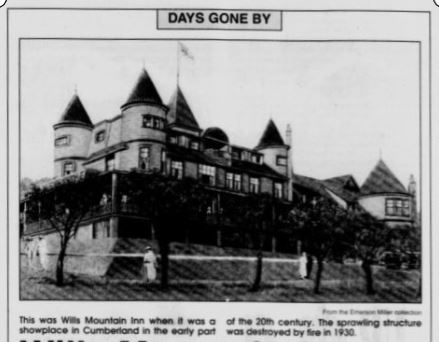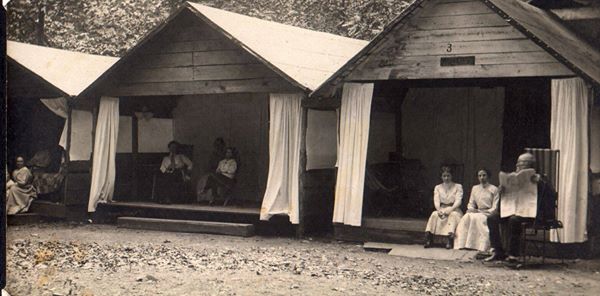|
Days Gone By
J. Suter Kegg

Wills Mountain former site of bustling hotel
Cumberland - If the seed for a monumental gambling casino is planted atop Wills Mountain overlooking Cumberland, as has been proposed, the fruit it produces will not be a first for this city.
Approximately a half-century ago a similar facility, although not nearly as elaborate as the one advocated by Winchester, Va. businessman James L. Silvester, operated on that same site. That one functioned only a short while before being converted into a dining establishment know as Taberna Monteum (Tavern on the Mountain).
That, too, functioned only a short while, being converted into a buiness plant. It is presently occupied by Artmor Plastics, Corp. owned and operated by Art Morgan.
Ninety-five years ago, however, a magnificent structure known as Wills Mountain Inn was built there, only to be destroyed by fire in the summer of 1930. Just a stone's throw from legendary Lovers' Leap, which overlooks the famous Cumberland Narrows, the inn stood 900 feet above the city and was 1, 500 feet above sea level.
A short walk from the imposing hostelry afforded guests a picturesque birds eye view below of meandering Wills Creek and U.S, Route 40, sandwiched between two railway lines, the Baltimore & Ohio and Western Maryland.
The main building of Wills Mountain Inn, as shown in the accompanying photograph, was three stories high with a stone and frame addition. It had 30 rooms, a kitchen, dining room and an entertainment hall. The building was equipped with a vapor steam plant for heating and several 60,000-gallon reservoirs furnished spring water for the inn.
On Dec. 10, 1902, the Wills Mountain Sanitarium Company took over the inn for the care of convalescents and invalids. It accommodated, as boarder by day, relatives and friends of patients. The wide piazzas (porches) enabled invalids to use their rolling chairs for transportation to ideal places for viewing the artistic scenery that, as one doctor put it "Only Mother Nature could paint."

Horse-drawn carriages from the sanitarium picked up patients at Cumberland railway stations and took them to the facility on Wills Mountain. Rates for patients were $25 to $40 weekly, prices being graded by location of the rooms. Rates included services of the resident physician, nursing in a general way, standard medicines and meals served in the room when required.
On Jan. 7, 1909, the sanitarium was used for a different purpose, serving as an institution for the treatment of alcohol and drug addictions. Dr. Henry D. Fry of Washington, D.C., was president of the Wills Mountain Sanitarium Company and Dr. James T. Johnson of Cumberland was one of the incorporators.
The rambling mountain showplace was built in 1899 by J.H. Holzshu and was opened July 20 that year by the Cumberland Lodge of the BPO Elks, dances and other social functions having been held there. Music for the dances was, for the most part, furnished by local bands.
Two of those musicians later became prominent on the local scene. They were Herman Miller, who became a self-styled historian of Cumberland's past and present, and Casper R. Taylor, Sr., who prospered as a local tavern owner. Both are deceased. Miller played the drums and Taylor, who son (Casper R. Taylor, Jr. serves as speaker of the Maryland House of Delegates), played the trumpet.
The resort burned to the ground in late afternoon of Tuesday, Aug. 5, 1930, during the height of a huge forest fire brought on by a summer drought. A.F. Uplinger, who resided at 504 Virginia Avenue, was helping to fight the mountain blaze which had been raging for two days and crept to within 1,500 feet of the inn. Uplinger had walked to the inn, hoping to secure food for him and the other men battling the conflagration when he saw flames inside the building.
Four adults and four children were inside the structure at the time and were warned to leave the premises immediately. They were driven by auto down the winding road leading to Piedmont Avenue, leaving most of their personal possessions behind.
New quickly spread about the fire and crowds of North-Enders gathered in the streets below to watch the spectacular inferno. The 800 block of Columbia Avenue, which runs to the foot of the mountain, provided one of the best sites for viewing the roaring spectacle.
Uplinger told investigation authorities that the building was quickly consumed, the entire structure having been ablaze within 20 minutes after he had made his discovery.
Stories concerning the cause of the inn fire were conflicting. J.T. Shewbridge, a forest warden, maintained that the blaze didn't get close enough to the resort to cause it to catch fire. Others said flying embers landed on the inn's rooftop and caused it to ignite.
In addition to the resort, a farm cottage belonging to Dr. Johnson, located near the inn, as well as the barn and outbuildings of the hostelry, were also destroyed.
Some years after the inn died in flames, efforts were made to pump new life into those same hills where the tribes of Shawnee Indians once roamed. In fact, one ot the streets leading to the foot of Wills Mountain (Shawnee Avenue) is named for those native Americans of old.
Constructed after World War II by William Roeder, a local contractor, at a lower lever where Wills Mountain Inn had stood, was a concrete-block building designed to be a first-class restaurant and night club. Named Taberna Monteum, it provided an outstanding outside dining area with a magnificent view of the city, especially at night, when street lights and neon signs resembled twinkling stars.
It was in part of that same building that gambling flourished in the mid-1940s when men and women who had served in World War II, returned to civilian life with a plethora of money they had saved while in uniform.
When this business ceased to be profitable, Harry Stern, later to become mayor of Cumberland, opened an electronics business there. Now it is the home of Artmor Plastics Corp., owned by Art Morgan, whose products are sold all over the world.
No one is living who can remember when the only loud noise erupting from Wills Mountain were the yell of the Shawnee Indian. But in 1948, when Taberna Monteum was still open, residents in North End were entertained by juke-box music that blared from giant loudspeakers outside of the tavern during the daylight hours.
The novelty was fascinating for a while but when only two songs came out of the speakers, residents began to complain. One of the songs was "Woody Woodpecker", which was then number one on the Charts. The other was "You Can't Be True, Dear", which knocked the Woodpecker off the top perch.
When the residents of North End protested en mass about the songs being more of a nuisance than entertainment, the City Fathers asked the proprietors to put a "silencer" on the amplifiers.
Wednesday, 19 October 1994, pages 17 & 18; Cumberland (MD) Times-News
(Courtesy of John McGowan; transcribed by Genie)
|





































































